Oil Crisis
-
- Study 56—'Sea Trade And Transportation Of Coal' Maritime Reporter, Nov 15, 1977 #41
The so-called 1973 "oil crisis" had an important effect upon the international trade in hard coal, as it did much to arrest the decline in the use of coal as an energy source. However, up until now, the seaborne trade in hard coal has been centered almost entirely on the coking coal requirements of a handful of industrialized nations, with steaming coal accounting for only a negligible percentage of total movements.
Indeed, coking coal requirements will continue to be a more dominent influence on the pattern of trade, although steaming coal shipments will expand to a significant extent. The object of STUDY 56 "SEA TRADE AND TRANSPORT OF COAL" is not to confine discussion to the different characteristics of the coking and steaming coal trades, but rather to examine the total pattern of seaborne hard coal movements and to assess their influence on seaborne transport.
PART 1 of the Study is primarily designed as an introduction to the seaborne coal trade, and as such, discussion is focused upon the main characteristics of the coal market, with specific reference to seaborne trade movements.
This is followed, in PART 2, by a much more detailed analysis of the supply of hard coal.
The existing production, seaborne exports and future development plans of both the traditional and more recent suppliers are identified and discussed. This part of the Study provides the basis for an analysis of the pattern of seaborne hard coal movements which forms the subject of PART 3.
Included within PART 3 are detailed matrices on the international seaborne hard coal trade for the years 1973, 1974 and 1975. The major importing regions and their role in the existing pattern of trade are also examined.
The likely future import requirements of these regions are estimated in PART 4, which includes forecasts of demand for seaborne hard coal for 1980 and 1985. Within PART 4, particular emphasis is placed upon the import requirements of both Japan and the EEC.
PART 5 considers the sea transport of coal, examines the changes that have occurred in the organization of the trade, the structure of transport costs, vessel types and sizes employed in the coal trade and the constraints imposed upon these by ports, concluding with a discussion of the future trends in sea transportation.
For a copy of Study No. 56— "SEA TRADE AND TRANSPORTATION OF COAL," write to HPD Shipping Publications, 34 Brook Street, Mayfair, London W1Y 2LL, England. Orders for overseas @ U.S. $75. U.K. only @ £30 per copy.
-
- ReFRESCO: Understanding & Designing Energy Saving Devices Maritime Reporter, Nov 2013 #18
introduced in 1980. Although the working principles responsible for the energy saving were not completely understood, in a world controlled by the second oil crisis, the MIDP was a great success. Shortly after, many other companies came with their own ESD designs. After the 80s, as the world economy recovered
-
- Crude Oil Supply And Tanker Demand Report Available From Drewry Maritime Reporter, Jan 15, 1980 #24
. Growth in aggregate world tanker demand has consequently been dampened, exacerbating the depression in the oil shipping sector. Since the 1973 Oil Crisis, a number of OPEC countries have adopted production ceilings in the interests both of conservation and of maximizing revenues in the long-term
-
- 'Ocean Trade And Transport Of Phosphate Rock7 Maritime Reporter, Sep 1978 #24
bulk commodities, the seaborne trade of phosphate rock has been adversely affected by the prolonged world economic depression which followed the "oil crisis" of 1973. This was most apparent in 1975 and 1976, when shipments fell to 26 percent below the peak level of 50 million tons attained in 1974
-
- D r e w r y Report R e v i e w s C a r - C a r r y i n g Fleet Maritime Reporter, May 1977 #42
a sizable one, has been fully employed, owners enjoying profitable freight rates. Yet world vehicle production and trade went into decline with the "Oil Crisis" and the onset of the economic slump, and have yet to recover to 1973 levels, as the latest study from H.P. Drewry (Shipping Consultants) Limited
-
- An Innovative LNG Carrier Concept Maritime Reporter, May 2003 #40
virtually stood still for many years as there has been practically no market for marine applications other than LNG carriers since the 1973 Oil Crisis. Diesel engines, by contrast, have come to dominate merchant ship propulsion, except for LNG carriers. The accumulated experience of thousands
-
- You Can Run, But You Can’t Hide Maritime Reporter, Feb 2014 #24
. The company scored a nice reference last year when it cooperated with Reuters to provide insights and analysis for the ongoing coverage of the Libyan oil crisis, Daniel said. Worker protests had halted oil exports from the country, and Windward was able to provide a full arena analysis on all tankers in and
-
- Fujiwara Takes the Helm at ClassNK Maritime Reporter, May 2016 #30
for the future and the inevitable market rebound. “The hardest time for the shipbuilding industry was the late 1970s, immediately following the oil crisis, when there were almost no shipbuilding jobs for a few years,” said Fujiwara. But in the mid-1970s the shipbuilding market was substantially different
-
- Is A Big Bulk Carrier A Good Bet? Maritime Reporter, Feb 15, 1980 #48
Entering the 1980s, it is hard to believe that it is now more than six years since the last "boom" in the big bulk carrier market was ended by the "Oil Crisis," and an abrupt change in the trading pattern of the combined fleet. For much of this period, operators of big bulk carriers—and by "big" one means
-
- Interview: Bourbon CEO Gael Bodénès Maritime Reporter, Apr 2018 #32
mean to Bourbon?We are in the worst crisis that we have ever seen on this market…. well beyond the Lehman Brothers crisis of 2009. Even in the 1980s oil crisis was not as violent as the situation we are facing today!We therefore cannot wait and shall be proactive and take exceptional measures to adapt to
-
- Oil Majors Push Offshore Players for 30% Cuts Maritime Reporter, Apr 2015 #44
work as many days as they possibly can, while avoiding excess time at the dock, those issues take on added significance,” says Billings. The longer the oil crisis continues, however, the more the foremost issue for most companies will be sheer survival. For those companies saddled with debt who can do little
-
- Southern Marine Industries Maritime Reporter, Feb 1991 #22
. Once things get settled there, we could be in for a rush of new construction, but we hope this time we can learn from the lessons of the last oil crisis. We want expansion, but this time we want it to be slow and steady." Mr. Dane is confident that the group will be able to land at least ten
-
 )
March 2024 - Marine Technology Reporter page: 42
)
March 2024 - Marine Technology Reporter page: 42versions Image courtesy Kongsberg Discovery are featured in the series, and all withstand reverse pressure, too, and can be installed into both dry and oil-? lled canisters. MacArtney introduced a space and weight-saving ø12.7 mm SubConn Nano, a Nano connector which offers a versatile and robust performance
-
 )
March 2024 - Marine Technology Reporter page: 39
)
March 2024 - Marine Technology Reporter page: 397 A 35Ah AGM lead-acid battery is tested using the West Mountain Radio CBA to show the effect of simply ? lling the battery voids with mineral oil as a compensating ? uid. The CBA is programmed to cut-off at a voltage of 10.50v. The top line (red) shows the unmodi? ed AGM battery capacity of
-
 )
March 2024 - Marine Technology Reporter page: 36
)
March 2024 - Marine Technology Reporter page: 36, Thus, there are no implodable spaces, and so are candidate and UPS, have speci? c guidelines available on their websites. cells for pressure-balanced, oil-? lled (PBOF) assemblies. This author has personally tested pouch LiPos to 20,000 psi im- Lead-Acid: The venerable lead-acid battery comes in three
-
 )
March 2024 - Marine Technology Reporter page: 35
)
March 2024 - Marine Technology Reporter page: 35.com/BPD.htm). have been tested ? Alkaline (alkaline-manganese dioxide): These prima- ry cells are available in the widest number of standard sizes, in oil-? lled bags and are commonly available around the world. This is handy to pressures of 20,000psi without if you are in a remote port and need
-
 )
March 2024 - Marine Technology Reporter page: 33
)
March 2024 - Marine Technology Reporter page: 33in the world.” How- ever, commercial success depends on many factors, not least a predictable OPEX. Over the past four years, SMD has worked with Oil States Industries to calculate cost per tonne ? gures for prospective customers. Patania II uses jet water pumps to Oil States’ Merlin riser systems
-
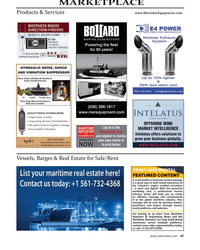 )
April 2024 - Maritime Reporter and Engineering News page: 47
)
April 2024 - Maritime Reporter and Engineering News page: 47.com Powering the fleet for 60 years! HYDRAULIC NOISE, SHOCK AND VIBRATION SUPPRESSOR Noise, Shock, VibraO on & PulsaO on in Quiet, Smooth Flow Out Oil Bladder Nitrogen (blue) Manufactured by MER Equipment Three Stage Noise & PulsaO on in ReducO on Chamber (206) 286-1817 www.merequipment.com QUALITY
-
 )
April 2024 - Maritime Reporter and Engineering News page: 41
)
April 2024 - Maritime Reporter and Engineering News page: 41maritime environments: • GMDSS/NAVTEX/NAVDAT coastal surveillance and transmission systems • Offshore NDB non-directional radio beacon systems for oil platform, support vessel & wind farm applications • DGPS coastal differential global positioning systems • VHF port communication systems Nautel
-
 )
April 2024 - Maritime Reporter and Engineering News page: 38
)
April 2024 - Maritime Reporter and Engineering News page: 38, including collecting MARPOL liquid The tanker vessel Archangel, 274 meters long and 85,474 and solid waste, transporting personnel and provisions, and oil gt, was moored using the 3-ton pulling capacity of the moor- spill response services. Images courtesy Consulmar Crowley's New LNG Containerships Carbon
-
 )
April 2024 - Maritime Reporter and Engineering News page: 35
)
April 2024 - Maritime Reporter and Engineering News page: 35becoming as interconnected as onboard sys- size training materials, including micro-learning videos, gam- tems. Kongsberg Digital has integrated NORBIT’s oil spill ing apps, VR programs and online mentoring. detection system with its K-Pos DP system for simulation- “These digital methods are more effective
-
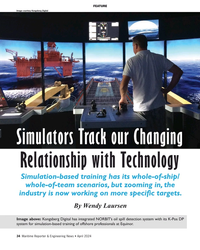 )
April 2024 - Maritime Reporter and Engineering News page: 34
)
April 2024 - Maritime Reporter and Engineering News page: 34scenarios, but zooming in, the industry is now working on more speci? c targets. By Wendy Laursen Image above: Kongsberg Digital has integrated NORBIT’s oil spill detection system with its K-Pos DP system for simulation-based training of offshore professionals at Equinor. 34 Maritime Reporter & Engineering
-
 )
April 2024 - Maritime Reporter and Engineering News page: 32
)
April 2024 - Maritime Reporter and Engineering News page: 32? xed wind. The subsidies won’t be a plentiful, and then a second on a luf? ng jib. This reduces the time it would there won’t be the same downturn in oil and gas that made all ordinarily take, weeks, to recon? gure the wiring of an ordi- the high-spec construction vessels available at attractive rates
-
 )
April 2024 - Maritime Reporter and Engineering News page: 27
)
April 2024 - Maritime Reporter and Engineering News page: 27ships like EPF require Force Sailors. We have 14 Henry J. Kaiser-class ? eet replen- high-speed craft (HSC) training. So, MyMSC will help track ishment oilers and three of the new John Lewis class of ? eet and manage all of those different things in one place. We’re replenishment oilers, with more on
-
 )
April 2024 - Maritime Reporter and Engineering News page: 25
)
April 2024 - Maritime Reporter and Engineering News page: 25vessels can MSC will see up to 20 new ships deliver to carry the equivalent of 30 C-17 transports. the ? eet in the next ? ve years. This includes new oil- Our Combat Logistics Force (CLF) is the key to keep- ing our ships at sea and in the ? ght, and sustain our forces ers, towing, salvage and rescue
-
 )
April 2024 - Maritime Reporter and Engineering News page: 21
)
April 2024 - Maritime Reporter and Engineering News page: 21along with our continued support to the in a UK design ? rm working in the North Sea marine industry,” said Langford. “We continue to hire key in- oil and gas platforms, the holy grail of rigorous dividuals and partner to provide best-in-class solutions.” R conditions in offshore energy production
-
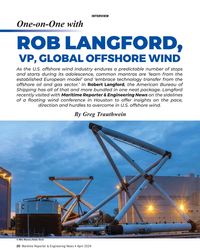 )
April 2024 - Maritime Reporter and Engineering News page: 20
)
April 2024 - Maritime Reporter and Engineering News page: 20and starts during its adolescence, common mantras are ‘learn from the established European model’ and ‘embrace technology transfer from the offshore oil and gas sector.’ In Robert Langford, the American Bureau of Shipping has all of that and more bundled in one neat package. Langford recently visited
-
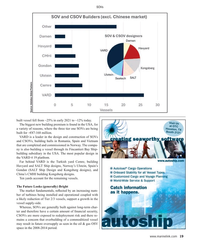 )
April 2024 - Maritime Reporter and Engineering News page: 19
)
April 2024 - Maritime Reporter and Engineering News page: 19more exposed to redeployment risk and there re- mains a concern that overbuilding of a commoditized vessel may result in future oversupply as seen in the oil & gas OSV space in the 2008-2014 period. www.marinelink.com 19 MR #4 (18-33).indd 19 4/5/2024 8:13:37 A
-
 )
April 2024 - Maritime Reporter and Engineering News page: 18
)
April 2024 - Maritime Reporter and Engineering News page: 18through dual fuel near shore Taiwanese market, which is also actively served by engines and (space for) a bunkering system. Currently metha- CTVs. Oil & gas offshore support vessels have been widely nol is a preferred energy carrier although hydrogen and liquid deployed to support construction logistics
-
 )
April 2024 - Maritime Reporter and Engineering News page: 17
)
April 2024 - Maritime Reporter and Engineering News page: 17or under construction in the North Euro- pean wind segment. Tier 2 and Tier 3 walk-to-work (W2W) vessels are cur- rently active in the segment, but as oil www.marinelink.com 17 MR #4 (1-17).indd 17 4/5/2024 8:40:33 A
-
 )
April 2024 - Maritime Reporter and Engineering News page: 16
)
April 2024 - Maritime Reporter and Engineering News page: 16charter to a wind turbine OEM or offshore wind in-built crane and gangway. farm operator to service and maintain equipment dur- ¦Tier 2: Generally, oil & gas tonnage (MPSVs, PSVs, ing the operations period of the wind farm. A typical etc.) with ? xed gangway, serving oil & gas and SOV will accommodat
-
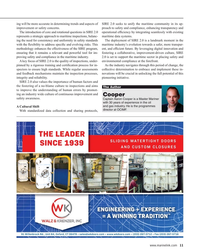 )
April 2024 - Maritime Reporter and Engineering News page: 11
)
April 2024 - Maritime Reporter and Engineering News page: 11wide culture of continuous improvement and Cooper safety awareness. Captain Aaron Cooper is a Master Mariner with 30 years of experience in the oil and gas industry. He is the programmes A Cultural Shift director at OCIMF. With standardized data collection and sharing protocols, THE LEADER SLIDING
-
 )
April 2024 - Maritime Reporter and Engineering News page: 10
)
April 2024 - Maritime Reporter and Engineering News page: 10users fully familiarize them- tion Report Program (SIRE 2.0). This initiative, led selves with the new regime, by using the portfolio of train- Tby the Oil Companies International Marine Forum ing materials and resources from OCIMF, has been key to (OCIMF), heralds a new era in vessel inspection, compliance
-
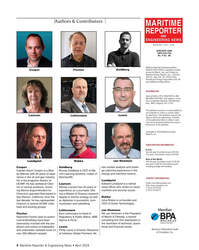 )
April 2024 - Maritime Reporter and Engineering News page: 4
)
April 2024 - Maritime Reporter and Engineering News page: 4is CEO of Ma- gic planning experience in the ter Mariner with 30 years of expe- rine Learning Systems, maker of energy and maritime sectors. rience in the oil and gas industry. MarineLMS. CONTACT INFORMATION: He is the programs director at Lundquist Email: [email protected] OCIMF. He has worked at Chev-
-
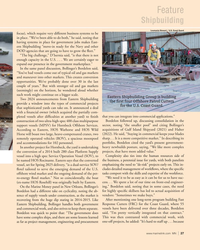 )
April 2024 - Marine News page: 27
)
April 2024 - Marine News page: 27to expand our presence in the government marketplace.” In the same panel discussion, Bollinger’s Bordelon said, “You’ve had vessels come out of typical oil and gas markets and maneuver into other markets. This creates conversion opportunities. We’ve probably done over 30 in the last couple of years.”
-
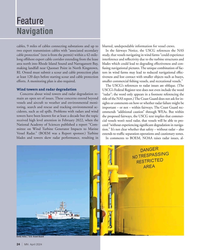 )
April 2024 - Marine News page: 24
)
April 2024 - Marine News page: 24radar failure might be toring, search and rescue and tracking environmental ac- important – or not – within fairways. The Coast Guard rec- cidents, such as oil spills. Problems with radars and wind ommends “additional caution” through WEAs. But within towers have been known for at least a decade but the topic
